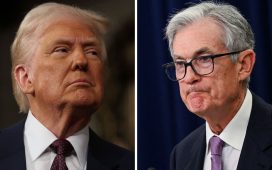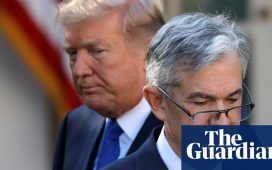This time last year, most economists expected the US Federal Reserve would be spending 2023 facing down a recession while fighting against the biggest wave of inflation for a generation.
Instead, the US has achieved the strongest growth of any large economy, unemployment is close to record lows, and price pressures are showing signs of creeping back to the central bank’s target of 2 per cent.
That better than expected run of data has led Fed chair Jay Powell to end the year by betting the credibility of the board he chairs on next year being almost as good as this one.
At its most recent rate-setting meeting, the Fed released its latest data showing that officials’ expect the central bank to cuts its benchmark federal funds rate — currently at a 22-year high of between 5.25 per cent and 5.5 per cent — by 75 basis points over the coming 12 months.
Baked into the forecasts from the Federal Open Market Committee is a belief that the US economy will achieve its soft landing, with inflation returning to the Fed’s goal, growth slowing only mildly and unemployment still reasonably low.
“You couldn’t draw up a more perfect economic scenario than the FOMC’s forecasts,” said Stephen Stanley, chief US economist at Santander. “If it happens, that would be tremendous. But there are only downside risks.”
Some believe that Powell’s confidence is premature and that officials’ dovishness could make it more difficult to emerge smoothly from months of elevated interest rates.
“The Fed’s projections are definitely a rosy view of the economy in 2024,” said James Rossiter, head of global macro strategy at TD Securities. “It’s certainly the outcome they desire, but we’re not sure they’re going to get away with it.”
The FOMC’s newfound optimism on the economy has taken many by surprise.
“Powell has a tough job. And over the past 18 months, he’s been very impressive,” said Gavyn Davies, chair of Fulcrum Asset Management. “But the Fed’s guidance has been very volatile lately.”
As recently as November, the Fed chair described the disinflation process as likely to be “lumpy” and “bumpy”. By mid-December, Powell was making the last mile of the fight to vanquish inflation sound a lot more straightforward.
“Inflation keeps coming down. The labour market keeps getting back into balance. And it’s so far so good,” he told reporters. “We kind of assume that it will get harder from here, but so far it hasn’t.”
After good news on inflation over the past quarter, officials expect the core personal consumption expenditures price index — their preferred measure of price pressures, which leaves out energy and food prices — to slow to 2.4 per cent next year, 2.2 per cent in 2025, and then hit their 2 per cent goal in 2026.
This smooth shift downwards — when coupled with the belief they can lower borrowing three times in 2024 — implies rate-setters think this wave of inflation has been mostly a supply-side phenomenon. That is, it was caused by pandemic-era shortages in labour and goods, not too much federal spending and loose monetary policy.
If they are right, then — barring any supply shocks, such as an oil-price jump or renewed disruption to global trade — price pressures should dissipate, even as the Fed eases.
Many analysts share rate-setters’ assessment and their projections for prices. “The general inflation picture is one of rapid normalisation,” said Rossiter at TD Securities. “That gives the Fed some comfort.”
But others warn that upside risks remain.
“If the progress we’ve see on inflation stalls and it doesn’t look as though we’re on such a clear path to 2 per cent in inflation, then the Fed’s tone will have to change,” said Stanley.
“I’m a little sceptical; I don’t think we’re going to continue to see the rapid improvement that we’ve seen in the past few months.”
Davies said favourable core PCE readings in the first three months of 2024 would be crucial in determining whether the Fed can cut rates during the spring. “A soft landing looks more probable now than six months ago because of the improvements in core inflation,” he said. “But it’s not a certainty.”
Since the December vote, officials have said that they intend to focus more in 2024 on the full employment aspect of their mandate than inflation.
One of the surprises of this year was the strength of the labour market, with unemployment remaining low, at just 3.8 per cent in November. The FOMC expects the jobless rate to tick up only modestly — to 4.1 per cent, a level still on par with full employment — as price pressures fall.
Such episodes of “immaculate disinflation”, where double-digit price rises have been conquered without a significant rise in joblessness, are rare.
Some economists think that the Fed’s forecasts are tantamount to wishful thinking.
“If the Fed were to avoid pre-emptive cuts, and leave interest rates unchanged until the second half of next year, then you would begin to see a material increase in the unemployment rate,” said Andrew Patterson, an economist at Vanguard. “To get inflation down to 2 per cent, we think you’d need to see wage growth at 3.5 per cent and unemployment rise to around 4.5 per cent.”
“We think there will be a recession in 2024. While it won’t be a major one, we are expecting to see a rise in unemployment to 4.6 per cent. That’s a fairly sizeable increase from what we have today,” said TD Securities’ Rossiter.
“All of the central banks are hoping for a perfect landing. But it’s hard to have that conviction in an environment where there are so many geopolitical risks. Despite how smoothly things have been going, we think 2024 is going to be a bumpy ride.”








